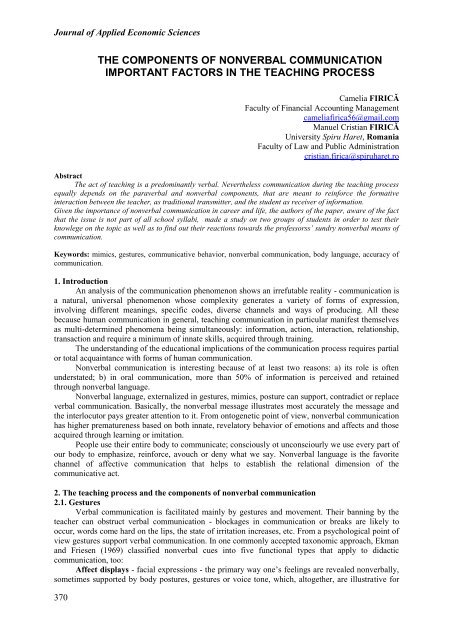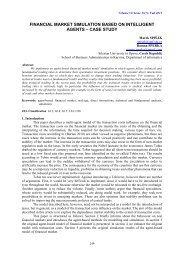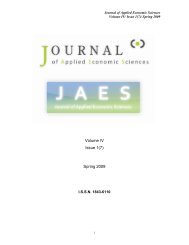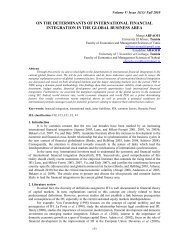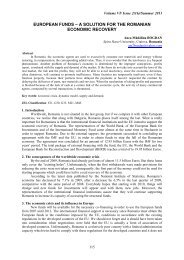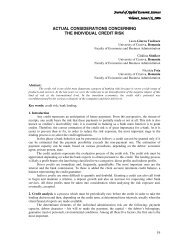the components of nonverbal communication important factors
the components of nonverbal communication important factors
the components of nonverbal communication important factors
Create successful ePaper yourself
Turn your PDF publications into a flip-book with our unique Google optimized e-Paper software.
Journal <strong>of</strong> Applied Economic Sciences<br />
THE COMPONENTS OF NONVERBAL COMMUNICATION<br />
IMPORTANT FACTORS IN THE TEACHING PROCESS<br />
370<br />
Camelia FIRICĂ<br />
Faculty <strong>of</strong> Financial Accounting Management<br />
cameliafirica56@gmail.com<br />
Manuel Cristian FIRICĂ<br />
University Spiru Haret, Romania<br />
Faculty <strong>of</strong> Law and Public Administration<br />
cristian.firica@spiruharet.ro<br />
Abstract<br />
The act <strong>of</strong> teaching is a predominantly verbal. Never<strong>the</strong>less <strong>communication</strong> during <strong>the</strong> teaching process<br />
equally depends on <strong>the</strong> paraverbal and <strong>nonverbal</strong> <strong>components</strong>, that are meant to reinforce <strong>the</strong> formative<br />
interaction between <strong>the</strong> teacher, as traditional transmitter, and <strong>the</strong> student as receiver <strong>of</strong> information.<br />
Given <strong>the</strong> importance <strong>of</strong> <strong>nonverbal</strong> <strong>communication</strong> in career and life, <strong>the</strong> authors <strong>of</strong> <strong>the</strong> paper, aware <strong>of</strong> <strong>the</strong> fact<br />
that <strong>the</strong> issue is not part <strong>of</strong> all school syllabi, made a study on two groups <strong>of</strong> students in order to test <strong>the</strong>ir<br />
knowlege on <strong>the</strong> topic as well as to find out <strong>the</strong>ir reactions towards <strong>the</strong> pr<strong>of</strong>essorss’ sundry <strong>nonverbal</strong> means <strong>of</strong><br />
<strong>communication</strong>.<br />
Keywords: mimics, gestures, communicative behavior, <strong>nonverbal</strong> <strong>communication</strong>, body language, accuracy <strong>of</strong><br />
<strong>communication</strong>.<br />
1. Introduction<br />
An analysis <strong>of</strong> <strong>the</strong> <strong>communication</strong> phenomenon shows an irrefutable reality - <strong>communication</strong> is<br />
a natural, universal phenomenon whose complexity generates a variety <strong>of</strong> forms <strong>of</strong> expression,<br />
involving different meanings, specific codes, diverse channels and ways <strong>of</strong> producing. All <strong>the</strong>se<br />
because human <strong>communication</strong> in general, teaching <strong>communication</strong> in particular manifest <strong>the</strong>mselves<br />
as multi-determined phenomena being simultaneously: information, action, interaction, relationship,<br />
transaction and require a minimum <strong>of</strong> innate skills, acquired through training.<br />
The understanding <strong>of</strong> <strong>the</strong> educational implications <strong>of</strong> <strong>the</strong> <strong>communication</strong> process requires partial<br />
or total acquaintance with forms <strong>of</strong> human <strong>communication</strong>.<br />
Nonverbal <strong>communication</strong> is interesting because <strong>of</strong> at least two reasons: a) its role is <strong>of</strong>ten<br />
understated; b) in oral <strong>communication</strong>, more than 50% <strong>of</strong> information is perceived and retained<br />
through <strong>nonverbal</strong> language.<br />
Nonverbal language, externalized in gestures, mimics, posture can support, contradict or replace<br />
verbal <strong>communication</strong>. Basically, <strong>the</strong> <strong>nonverbal</strong> message illustrates most accurately <strong>the</strong> message and<br />
<strong>the</strong> interlocutor pays greater attention to it. From ontogenetic point <strong>of</strong> view, <strong>nonverbal</strong> <strong>communication</strong><br />
has higher prematureness based on both innate, revelatory behavior <strong>of</strong> emotions and affects and those<br />
acquired through learning or imitation.<br />
People use <strong>the</strong>ir entire body to communicate; consciously ot unconsciourly we use every part <strong>of</strong><br />
our body to emphasize, reinforce, avouch or deny what we say. Nonverbal language is <strong>the</strong> favorite<br />
channel <strong>of</strong> affective <strong>communication</strong> that helps to establish <strong>the</strong> relational dimension <strong>of</strong> <strong>the</strong><br />
communicative act.<br />
2. The teaching process and <strong>the</strong> <strong>components</strong> <strong>of</strong> <strong>nonverbal</strong> <strong>communication</strong><br />
2.1. Gestures<br />
Verbal <strong>communication</strong> is facilitated mainly by gestures and movement. Their banning by <strong>the</strong><br />
teacher can obstruct verbal <strong>communication</strong> - blockages in <strong>communication</strong> or breaks are likely to<br />
occur, words come hard on <strong>the</strong> lips, <strong>the</strong> state <strong>of</strong> irritation increases, etc. From a psychological point <strong>of</strong><br />
view gestures support verbal <strong>communication</strong>. In one commonly accepted taxonomic approach, Ekman<br />
and Friesen (1969) classified <strong>nonverbal</strong> cues into five functional types that apply to didactic<br />
<strong>communication</strong>, too:<br />
Affect displays - facial expressions - <strong>the</strong> primary way one’s feelings are revealed <strong>nonverbal</strong>ly,<br />
sometimes supported by body postures, gestures or voice tone, which, altoge<strong>the</strong>r, are illustrative for
Volume V/ Issue 4(14)/ Winter 2010<br />
one’s affective, emotional state. Raising eyebrows, frowning or tilting head backwards when<br />
surprised, making a face when disgusted, staring or frowning when angry, smiling when happy or<br />
sympathizing, tightening <strong>of</strong> a fist, covering eyes, ears or mouth as denial to see, hear or say something,<br />
<strong>the</strong>se are all expressions <strong>of</strong> affect displays. Affect displays can be also used to influence or manipulate<br />
o<strong>the</strong>rs: a speaker, for example, displays enthusiasm and hopes it exudes to <strong>the</strong> audience, children will<br />
<strong>of</strong>ten cry to simply get attention.<br />
There are eight basic emotions common to all cultures that <strong>the</strong> face can display: happiness,<br />
surprise, fear, anger, sadness, disgust, contempt, and interest and each basic emotion has a distinctive<br />
facial expression and for most <strong>of</strong> <strong>the</strong>m <strong>the</strong>re is evidence <strong>of</strong> distinctive physiological responses,<br />
distinctive changes in <strong>the</strong> voice and evidence <strong>of</strong> cognitive phenomena like focusing attention on <strong>the</strong><br />
emotion stimulus. (Griffiths, 2010).<br />
A combination <strong>of</strong> all <strong>the</strong>se basic facial expressions can appear on <strong>the</strong> face at <strong>the</strong> same time<br />
depending on <strong>the</strong> intensity <strong>of</strong> <strong>the</strong> emotion portrayed. (Roberts, 186). When <strong>the</strong>y are true <strong>the</strong>y appear<br />
involuntarily while <strong>the</strong> false ones are characteristic to actors, liars, sales people who can put on a<br />
neutral face. Affect displays are extremely <strong>important</strong> because people tend to focus attention on affect<br />
displays as feedback during <strong>communication</strong>. Since affect displays convey <strong>the</strong> transmitter’s feelings<br />
<strong>the</strong>y can facilitate <strong>the</strong> relation adult-child, pr<strong>of</strong>essor-student.<br />
Regulators as <strong>nonverbal</strong> cues, whose frequency is determined by <strong>the</strong> addressee’s presence, -<br />
such as eye movements, head nods, tonal variations and body movements like turn-taking cues - are<br />
used to control and support verbal <strong>communication</strong>, to regulate interaction, indicating <strong>the</strong> addresser to<br />
continue, repeat, elaborate, hurry up, stop speaking, and so on. People nod, smile, make ―mm-hmm‖<br />
sounds to show agreement with <strong>the</strong> speaker or that <strong>the</strong>y are listening, shake head, narrow <strong>the</strong>ir eyes, or<br />
pout to show disagreement. O<strong>the</strong>rs break eye contact or change posture to shows boredom or lack <strong>of</strong><br />
participation. Voice inflections and gestures that signal whose turn it is to talk, as well as a raised arm<br />
that indicates <strong>the</strong> desire to speak are fur<strong>the</strong>r examples <strong>of</strong> regulators in conversation. Context is<br />
<strong>important</strong> to accurately interpret regulators as well—someone who is bouncing a leg during a lecture<br />
may be indicating boredom, but if one is listening to music bouncing may be a sign <strong>of</strong> keen interest.<br />
Regulators fulfill expressive and phatic functions because <strong>the</strong>y reveal <strong>the</strong> attitude towards <strong>the</strong><br />
interaction <strong>of</strong> <strong>the</strong> participants, <strong>the</strong>y are extremely <strong>important</strong>, habitual, learned, and almost involuntary.<br />
Illustrators or iconic gestures as <strong>nonverbal</strong> cues are directly, closely related to speech,<br />
illustrating what is being said. Illustrators are useful as <strong>the</strong>y add detail to <strong>the</strong> mental image that <strong>the</strong><br />
addresser is trying to transmit: <strong>the</strong>y allow <strong>the</strong> speaker to stress or emphasize words or ideas thus<br />
reinforcing, supporting and completing verbal message. Being acquired by learning, illustrators reveal<br />
<strong>the</strong> individual’s social experience and indicate direction (up / down <strong>the</strong>re /here, far, forward / back),<br />
shape (rectangle, spiral, circle) size (large, small), person (you, me, him), way <strong>of</strong> action (slow / fast).<br />
The timing <strong>of</strong> iconic gestures in synchronization with speech can show one whe<strong>the</strong>r <strong>the</strong>y are<br />
unconscious or are being deliberately added for conscious effect. In case <strong>of</strong> unconscious usage, <strong>the</strong><br />
preparation for <strong>the</strong> gesture will start before <strong>the</strong> words are said, whilst in conscious usage <strong>the</strong>re is a<br />
small lag between words and gesture which can make <strong>the</strong> speaker appear manipulative.<br />
Emblems are particularly relevant, specific gestures, consciously used as substitutes for words<br />
which have a direct verbal translation, generally a word or phrase (e.g. head movement for Yes / No,<br />
accomplice eye blink, finger to her lips - for silence, open palm meaning stop or utterances such as<br />
Shhh, for Be quiet). Emblems occur mainly when verbal <strong>communication</strong> is inhibited by external<br />
<strong>factors</strong> (noise, distance), carry less personal information than o<strong>the</strong>r forms <strong>of</strong> <strong>nonverbal</strong> cues, allowing<br />
<strong>the</strong> speaker to communicate just simple ideas in general universally understood though some are<br />
culture specific.<br />
Adaptors are movements that satisfy personal needs and help one adapt to environment, actions<br />
that release physical or emotional tension when someone is anxious or behaviors, or objects that are<br />
manipulated intentionally. Adaptors include behaviors like adjusting one’s glasses, knuckles, twirling<br />
hair, or biting fingernails. In some cases <strong>the</strong>se behaviors are actually relaxing, but <strong>of</strong>ten <strong>the</strong>y’re simply<br />
done out <strong>of</strong> habit, and are class <strong>of</strong> gestures hardly related to <strong>communication</strong>.<br />
In <strong>the</strong>ir turn, students also make use <strong>of</strong> <strong>nonverbal</strong> <strong>communication</strong> (head nodding, frowning as<br />
sign <strong>of</strong> atention, while attending a lecture, reproachful gaze directed towards disturbing, fidgeting<br />
colleague) in <strong>the</strong>ir reactions in class, which, if correctly interpreted, have <strong>the</strong> valuable <strong>of</strong> feedback for<br />
pr<strong>of</strong>essors.<br />
371
Journal <strong>of</strong> Applied Economic Sciences<br />
2.2. Facial expressions and eye contact<br />
Facial behavior particularly intentional as it is a conscious act, is a very visible part <strong>of</strong><br />
<strong>communication</strong>, expresses feelings, speaks about attitude, state <strong>of</strong> mind, mood which change during<br />
interaction and are continuously monitored by <strong>the</strong> recipient. A major feature <strong>of</strong> interpersonal and<br />
group <strong>communication</strong> is eye contact; by looking or not looking at someone people can communicate<br />
<strong>the</strong>ir attitude toward <strong>the</strong> interlocutors. Through eye contact <strong>the</strong> flow <strong>of</strong> <strong>communication</strong> is regulated<br />
and <strong>communication</strong> effectiveness and audience’s feedback monitored. Becoming aware when<br />
audience are listening or feel bored, is a feedback <strong>the</strong> addresser can use to change <strong>the</strong> subject or <strong>the</strong><br />
way it was approached, stop <strong>the</strong> dissertation, or proceed. The feedbacks obtained from watching <strong>the</strong><br />
students’ <strong>nonverbal</strong> cues, <strong>of</strong> which facial expression detains a top position, will allow <strong>the</strong> pr<strong>of</strong>essor<br />
understand to what degree students are engaged and participate in <strong>the</strong> process.<br />
According to Mark Knapp (apud Dinu 1999, 245) visual <strong>communication</strong> fulfils four functions:<br />
- asking for information; look, as means <strong>of</strong> achieving interaction, plays an <strong>important</strong> role in<br />
getting feedback; when <strong>the</strong> addressee listens with wide open eyes <strong>the</strong> addresser understands <strong>the</strong><br />
amount <strong>of</strong> interes in <strong>the</strong> subject and fur<strong>the</strong>r details are necessary;<br />
- giving permission to o<strong>the</strong>rs to speak; in case <strong>of</strong> group <strong>communication</strong> <strong>the</strong> permission to speak<br />
can be granted to ano<strong>the</strong>r both verbally but also by means <strong>of</strong> deictic look orientation; this most <strong>of</strong>ten<br />
happen in class when <strong>the</strong> teacher allows his students to speak or indicates who is to speak by means <strong>of</strong><br />
eyes;<br />
- indicating <strong>the</strong> type <strong>of</strong> relation; <strong>the</strong> type <strong>of</strong> relations between <strong>the</strong> speaker and interlocutors is<br />
indicated by <strong>the</strong> orientation and <strong>the</strong> period <strong>of</strong> time <strong>the</strong> look lasts: superiors who try to dominate<br />
usually stare while addressing <strong>the</strong>ir subordinates while, on <strong>the</strong> contrary, in case <strong>the</strong>y want to<br />
emphasise a disregarding attitude or disagreement with <strong>the</strong>ir inferiors’ opinions <strong>the</strong>y avoid looking <strong>the</strong><br />
later when <strong>the</strong>y speak;<br />
- compensating or reducing <strong>the</strong> physical distance; look can establish a visual proxemics<br />
between persons separated by distance. The direction, moment and duration <strong>of</strong> an addresser’s look are<br />
<strong>important</strong> clues, eloquent <strong>of</strong> his attitude, feelings and emotional sate (like, dislike, self-confidence,<br />
attention, respect, consideration, sincerety etc.) towards <strong>the</strong> addressees whose feedback will influence.<br />
Speakers who make <strong>the</strong> least eye contact, look to <strong>the</strong> side and turn <strong>the</strong>ir body away are defensive,<br />
cold, immature, deceitful persons in <strong>the</strong> eyes <strong>of</strong> <strong>the</strong> listeners who find this frustrating and insulting,<br />
while those who settle longer eye contact and position <strong>the</strong>ir body and head squarely towards <strong>the</strong><br />
audience are judged as friendly, mature, sincere, reliable and self-confident. A good public speaker<br />
must speak with his eyes, by sweeping <strong>the</strong> audience with his eyes, making brief eye contact with as<br />
many individuals in <strong>the</strong> audience as possible.<br />
2.3. Paralanguage<br />
Paralanguage is <strong>communication</strong> that goes beyond <strong>the</strong> specific spoken words. It includes<br />
pitch, amplitude, rate, and voice quality <strong>of</strong> speech. Paralanguage reminds us that people<br />
convey <strong>the</strong>ir feelings not only in what <strong>the</strong>y say, but also in how <strong>the</strong>y say it. (Robbins,<br />
Langton, 2001)<br />
It most <strong>of</strong>ten prevails over <strong>the</strong> meaning <strong>of</strong> spoken words. The tone and <strong>the</strong> speed <strong>of</strong> one’s voice,<br />
<strong>the</strong> pitch, ranging from deep to high, are essential parts <strong>of</strong> paralanguage <strong>important</strong> in <strong>the</strong> act <strong>of</strong><br />
<strong>communication</strong>. Listeners are inclined to rate as more credible and captivating <strong>the</strong> addressers who<br />
speak at a slightly higher than normal rate <strong>of</strong> speech, articulate <strong>the</strong>ir words clearly, stress <strong>the</strong>m<br />
appropriately.<br />
Likewise, o<strong>the</strong>r aspects <strong>of</strong> paralanguage can impact <strong>the</strong> speaker’s appearance <strong>of</strong> credibility and<br />
intelligence: Check backs are verbal ticks (know what I mean?, Okay?, Right) , interjections (Um, Uh,<br />
Err, Ah), filler words (Like, Whatever, So to spewak, I mean) when overused <strong>the</strong>y get in <strong>the</strong> way <strong>of</strong><br />
effective <strong>communication</strong>, annoy listeners and may suggest ineptitude on <strong>the</strong> speaker’s part.<br />
2.4. Posture<br />
Posture communicates primarily <strong>the</strong> social status <strong>of</strong> individuals and gives information about<br />
attitudes, emotions, degree <strong>of</strong> courtesy, warmth <strong>of</strong> <strong>the</strong> soul, etc.<br />
People’s posture, regarding <strong>the</strong> relationship between <strong>the</strong>m is:<br />
372
Volume V/ Issue 4(14)/ Winter 2010<br />
- <strong>of</strong> inclusion/non-inclusion - a position which defines <strong>the</strong> space available for <strong>communication</strong><br />
and limits access to <strong>the</strong> group.<br />
- congruent/ noncongruent - communicates to what degree a person participates to what <strong>the</strong><br />
interlocutor says or does. Intense involvement leads to a position similar to that <strong>of</strong> <strong>the</strong> listener’s, while<br />
noncongruent posture indicated divergence in attitude or status and implies lack <strong>of</strong> any interaction.<br />
These are very <strong>important</strong> positions in <strong>the</strong> act <strong>of</strong> teaching, teachers should consider.<br />
- <strong>of</strong> orientation - refers to <strong>the</strong> fact that two people can choose to sit face to face or next to each<br />
o<strong>the</strong>r. The first situation communicates predisposition for conversation, as it is <strong>the</strong> case with <strong>the</strong><br />
pr<strong>of</strong>essors and students in a classroom, and <strong>the</strong> second - neutrality.<br />
3. Case study<br />
The authors <strong>of</strong> this article made, during <strong>the</strong> tutorial classes, a study including two <strong>of</strong> <strong>the</strong> student<br />
groups <strong>of</strong> <strong>the</strong> Financial Accounting Management and <strong>of</strong> Law and Public Administration Faculties.<br />
Each group <strong>of</strong> students contained 25 students; <strong>the</strong> day <strong>the</strong> experiment was done <strong>the</strong>re were 21 students<br />
present in <strong>the</strong> Law group, 20 in <strong>the</strong> Financial Accounting Management group. They purposely chose<br />
students <strong>of</strong> <strong>the</strong> first year <strong>of</strong> study and <strong>the</strong> experiment was carried on during <strong>the</strong> first semester <strong>of</strong> <strong>the</strong><br />
academic year.<br />
We mention that previously students had been tested about any contingent knowledge <strong>of</strong> <strong>the</strong><br />
subject - <strong>nonverbal</strong> <strong>communication</strong> - hardly part <strong>of</strong> school curriculum in Romania. Pictures illustrating<br />
affect displays, regulators, illustrators and emblems were showed to <strong>the</strong> students who were asked to<br />
identify <strong>the</strong> feelings, attitudes, emotions or meanings depicted.<br />
80% respectively 84% <strong>of</strong> <strong>the</strong> students <strong>of</strong> <strong>the</strong> two groups were able to discern <strong>the</strong> meanings<br />
correctly but <strong>the</strong>y admitted it was primarily out <strong>of</strong> personal life experience and intuition and not as a<br />
consequence <strong>of</strong> former thorough study (parents or grandparents very <strong>of</strong>ten asked <strong>the</strong>m during<br />
childhood to act or behave in a certain way <strong>the</strong> moment <strong>the</strong>y were looked at, in <strong>the</strong> company <strong>of</strong> o<strong>the</strong>rs,<br />
in public spaces at kindergarten and later at school); nor were <strong>the</strong> students aware <strong>of</strong> <strong>the</strong> existing<br />
cultural differences in this respect. It is interesting to point out that <strong>the</strong>y all asserted that <strong>the</strong> authors <strong>of</strong><br />
<strong>the</strong> popular moral precepts relied more on intuition, less on scientific knowledge <strong>of</strong> <strong>nonverbal</strong><br />
language. Their examples were: Sweet talk helps, The tone makes <strong>the</strong> music, Silence is gold, Eyes are<br />
<strong>the</strong> mirror <strong>of</strong> <strong>the</strong> soul, Facts cry louder that words.<br />
It had been noticed that during <strong>the</strong> seminars, when <strong>the</strong>re were discussed issues that students<br />
ought to have prepared <strong>the</strong>mselves, two groups distinguished: <strong>the</strong> great majority <strong>of</strong> students who used<br />
to study thoroughly, and a relatively small one who usually failed to fulfill <strong>the</strong>ir assignment, relying<br />
only on issues <strong>the</strong> pr<strong>of</strong>essors had exposed during <strong>the</strong> courses and had only vague knowledge <strong>of</strong> <strong>the</strong><br />
academic issues under discussion. Intentionally, <strong>the</strong>se became <strong>the</strong> subject <strong>of</strong> <strong>the</strong> experiment.<br />
The assistant pr<strong>of</strong>essors adopted two attitudes: <strong>the</strong> first one characterized by a relaxed stance<br />
(sitting or standing at a distance <strong>of</strong> about one meter away from <strong>the</strong> speaker) and a jovial attitude; eye<br />
contact was a constant <strong>of</strong> <strong>communication</strong> with <strong>the</strong> student who was encouraged by nodding or o<strong>the</strong>r<br />
movements <strong>of</strong> <strong>the</strong> head and hands and raised eyebrows, a slightly perceptible smile whenever his/her<br />
ideas were correct. All <strong>the</strong>se were meant to provide reinforcement, make <strong>the</strong> student confident and<br />
determine <strong>the</strong>m to keep on speaking. Occasionally, <strong>the</strong> teacher used calm voice to utter words <strong>of</strong><br />
encouragement such as: correct, please continue, right, etc., made mm-hmm sounds to show<br />
agreement. During <strong>the</strong> English class - one <strong>of</strong> <strong>the</strong> authors’ field - gestures were used to suggest<br />
different notions - possession, place, shape, size - and help <strong>the</strong> subject to dare to use <strong>the</strong>m in case <strong>the</strong>y<br />
were in doubt. The speaker’s sense <strong>of</strong> uncertainty was fading away, self confidence gaining ground.<br />
When <strong>the</strong> situation required that certain matters be explained or clarified by <strong>the</strong> assistant<br />
pr<strong>of</strong>essor this began by referring to <strong>the</strong> speaker’s intervention using <strong>the</strong> words: as your colleague<br />
mentioned ... as your fellow student correctly remarked...etc.<br />
The result was that, although <strong>the</strong> way <strong>the</strong> students had fulfilled <strong>the</strong>ir task was not satisfactory,<br />
<strong>the</strong>y still managed to bear a conversation based on <strong>the</strong> knowledge acquired during <strong>the</strong> pr<strong>of</strong>essor’s<br />
lecture, being encouraged by <strong>the</strong> kind, sympa<strong>the</strong>tic attitude <strong>of</strong> <strong>the</strong> assistant pr<strong>of</strong>essor. Subsequently,<br />
<strong>the</strong>y were explained what had been intended and acknowledged that this attitude was felt like a<br />
support and helped <strong>the</strong>m face <strong>the</strong> challenge.<br />
A contrary approach was taken to ano<strong>the</strong>r group <strong>of</strong> students: pr<strong>of</strong>essors displayed a rigid<br />
attitude: with folded arms or fingers pounding on <strong>the</strong> table because <strong>of</strong> boredom or irritation, rigid face,<br />
373
Journal <strong>of</strong> Applied Economic Sciences<br />
frowning eyebrows, mouth closed to disapproval or an ironical smile addressed to <strong>the</strong> students who<br />
had failed <strong>the</strong>ir assignment. All this, associated with occasional visual contact and discouraging words<br />
such as: I do not think so!, You don’t say so!, Not really, Really? etc.<br />
The result was that students, subject to such a deliberately inappropriate behavior, ended by<br />
refusing <strong>communication</strong>, feeling embarrassed to o<strong>the</strong>r colleagues and pr<strong>of</strong>essor alike. They admitted<br />
this during a prior discussion when <strong>the</strong>y were explained <strong>the</strong> purpose <strong>of</strong> <strong>the</strong> experiment <strong>the</strong>y had had to<br />
face. They hardly had confidence to speak or answer simple questions about topics familiar to <strong>the</strong>m.<br />
Finding out that non-verbal <strong>communication</strong> stirred <strong>the</strong> students’ interest <strong>the</strong> authors <strong>of</strong> <strong>the</strong><br />
article indicated bibliography illustrative for <strong>the</strong> issue, considering its importance in <strong>the</strong> context <strong>of</strong> <strong>the</strong><br />
two faculties’ students’ training for <strong>the</strong>ir future careers in law, accounting respectively.<br />
4. Conclusions<br />
In teaching <strong>communication</strong> paraverbal and <strong>nonverbal</strong> <strong>communication</strong> form a well structured,<br />
complex and convergent whole as <strong>the</strong>y are more quickly interpreted and precisely understood than<br />
verbal <strong>communication</strong>; in most cases <strong>nonverbal</strong> <strong>communication</strong> - a gesture, a look, mimics - gives<br />
sense and meaning to <strong>the</strong> message.<br />
Affective experiences and attitudes necessary for <strong>the</strong> relational dimension <strong>of</strong> <strong>communication</strong> -<br />
are conveyed better and more easily by paraverbal and <strong>nonverbal</strong> <strong>communication</strong>.<br />
The authors realized that what students knew about <strong>the</strong> topic was mainly intuitively and less<br />
based on thorough study. Their inferences about <strong>the</strong> pr<strong>of</strong>essors’ attitudes barely relied on specialized<br />
training. (Ekman and Friesen, 1969:50) Being aware <strong>of</strong> <strong>the</strong> importance <strong>of</strong> <strong>nonverbal</strong> <strong>communication</strong> in<br />
career and life (how to face a job interview, how to deal with clients or customers and build <strong>the</strong>ir<br />
feelings <strong>of</strong> trust, how to sell a service, a product, etc.), <strong>the</strong> authors suggest that <strong>the</strong> curricula should<br />
provide <strong>the</strong> students <strong>of</strong> <strong>the</strong> two faculties <strong>the</strong> opportunity to approach <strong>the</strong> subject scientifically.<br />
References<br />
[1] Cucoş, C. 1998. Psihopedagogie. Editura Polirom. Iaşi.<br />
[2] Dinu, M. 2000. Comunicarea. Editura Algos. Bucureşti.<br />
[3] Dinu, M. 1999. Comunicarea. Repere fundamentale. Editura Ştiinţifică. Bucureşti.<br />
[4] Ekman, P., Friesen, W.V., 1969. The repertoire <strong>of</strong> <strong>nonverbal</strong> behavior: Categories, origins, usage,<br />
and coding, Semiotica, 1: 49–98.<br />
[5] Leroy, G., 1974. Dialogul în educatie. Editura Didactică şi Pedagogică, Bucureşti.<br />
[6] Griffiths, Paul E. Basic Emotions, Complex Emotions, Machiavellian Emotions,<br />
http://paul.representinggenes.org/.<br />
[7] Paun, E. 1982. Socio pedagogie scolara. Editura Didactică si Pedagogică. Bucureşti.<br />
[8] Robbins, S., and Langton, N. 2001. Organizational Behaviour: Concepts, Controversies,<br />
Applications. Upper Saddle River, NJ: Prentice-Hall. http://www.usemod.com./<br />
[9] Roberts, Steve. Character animation in 3D. http://books.google.ro/.<br />
[10] Soitu, L. 1995. Pedagogia comunicarii. Editura Didactică şi Pedagogică. Bucureşti.<br />
[11] Wiener, M., Devoe, S., Rubinow, S., and Geller, J. 1972. Nonverbal behavior and <strong>nonverbal</strong><br />
<strong>communication</strong>, Psychological Review, 79: 185-214.<br />
374


